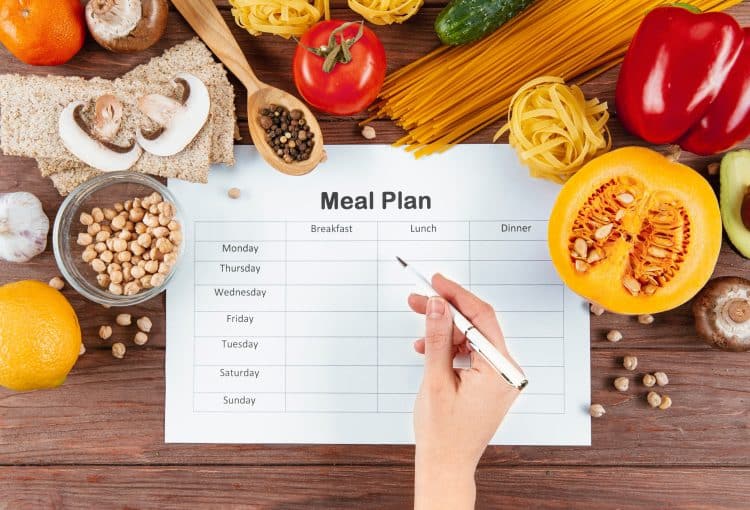The average American daily caloric intake is approximately 1,800 to 2,400 calories for women and 2,400 to 3,000 for men, as reported by the U.S. Department of Agriculture’s 2010 Dietary Guidelines. [1]
When an average American gains weight, they, in the back of their head, know it is probably because they have been overeating. However, most try to remedy it by randomly cutting their food intake.
Only a few ever take the time to learn about calories, the role of macronutrients, and how they can affect overall health and well-being.
The result?
Most give up on the weight loss efforts before meeting their objective.
In this article, we delve into more details about the average American daily caloric intake, the ideal calorie needs versus the actual intake, the most common sources of calories, the health implications of eating more calories than required, and the practical tips for managing calorie intake.
Level Up Your Fitness: Join our 💪 strong community in Fitness Volt Newsletter. Get daily inspiration, expert-backed workouts, nutrition tips, the latest in strength sports, and the support you need to reach your goals. Subscribe for free!
Introduction — Average American Daily Caloric Intake
How we approach food (and calorie intake) has changed significantly since the 1970s.
Back in the ’70s, fast food was a rare indulgence, and portion sizes were more modest. People enjoyed wholesome, home-cooked meals and didn’t have to worry too much about the amount of calories and their macronutrient content.
Life would be so much easier if we were still eating sweet potato and eggs for breakfast and chicken breast and rice for lunch.
But here we are, in the midst of a fast-food revolution, where Subway, McDonald’s and KFC have become household names.
Fast food is disturbingly unhealthy. Fast foods, like cheeseburgers and fries from popular chains, often pack a substantial portion of your daily recommended calorie intake [2]. A high-caloric diet has been linked to metabolic disorders like obesity, type 2 diabetes, and metabolic syndrome. [3]
Caloric Needs vs. Actual Intake
As mentioned in the article’s opening, the average American daily caloric intake is 1,800 to 2,400 calories for women and 2,400 to 3,000 for men. However, these numbers are based on self-reported data and are likely much lower than the actual amounts consumed.
However, a study published in the Annals of Epidemiology suggested that calorie intake is often underestimated by about 25%. This implies that Americans might actually be consuming between 2,231 to 3,300 calories daily on average. [4]
Given the data, it’d be safe to say that most Americans eat more calories than required, which can lead to dire health consequences.
Now, you might be thinking, “Why are Americans consistently exceeding these recommended values?”
Well, it’s a complex web of factors. The abundance of processed foods, oversized restaurant portions, and increasingly sedentary lifestyles contribute to this caloric surplus.
Plus, people tend to underestimate their calorie intake and overestimate their physical activity. The good old human psychology is doing what it does best.
Most people conveniently forget the extra snack they had in the evening and the sugar-laden coffee before dinner. It doesn’t end here; most of us think we burned more calories during that workout than we actually did.
The difference between reported and actual calorie intake can make it challenging to assess our dietary habits accurately. It also makes designing a diet and training program to lose weight challenging.
Calorie Intake Recommendations
Here are the recommended daily calorie goals for males and females of different age groups: [5]
| Age | Men | Women |
| 19–30 years | 2,400–3,000 calories | 1,800–2,400 calories |
| 31–40 years | 2,400–3,800 calories | 1,800–2,200 calories |
| 41–50 years | 2,200–2,800 calories | 1,800–2,200 calories |
| 51–60 years | 2,200–2,800 calories | 1,600–2,200 calories |
| 61–70 years | 2,000–2,600 calories | 1,600–2,200 calories |
| 71+ years | 2,000–2,600 calories | 1,600–2,200 calories |
According to the USDA, the ideal average American daily caloric intake recommendation for men is approximately 2,767 calories per day, while it is around 2,133 calories for women.
Remember, you should never blindly copy someone else’s diet or daily calorie goal.
The average daily caloric intake can vary widely depending on factors like age, sex, weight, height, metabolism, physical activity level, and training goals.
For example, middle-distance runners usually have a high daily calorie intake goal due to increased physical demands.
A 3,500-calorie daily target for a sedentary individual can be detrimental, as it can put them in a calorie surplus, leading to weight gain.
People with pre-existing medical conditions must consult their healthcare provider before starting a new training or diet regimen.
Caloric Intake and Health Implications
Calorie intake is directly related to your body weight.
Staying in a calorie surplus, which involves consuming more calories than you expend, for an extended period can lead to weight gain.
The excess food we eat is turned into glycogen (fat) and stored in the skeletal muscles (∼500 g) and the liver (∼100 g), which our bodies burn for energy.
However, consistently consuming more calories than you need expands the glycogen reserves, leading to weight gain. An extended calorie surplus can eventually tip the scales toward obesity.
According to the Centers for Disease Control and Prevention (CDC), consuming a surplus of 500 calories daily for a week can lead to a 1-pound weight gain. [6]
Importance of Understanding Personal Caloric Needs
Weight loss or weight gain is a simple function of calories in versus calories out.
To maintain your current weight, you must balance the number of calories you consume with the number you burn through daily activities and exercise.
Conversely, to lose weight, you must burn more calories than you consume — referred to as a calorie deficit.
Level Up Your Fitness: Join our 💪 strong community in Fitness Volt Newsletter. Get daily inspiration, expert-backed workouts, nutrition tips, the latest in strength sports, and the support you need to reach your goals. Subscribe for free!
Managing your calories is like a mathematical equation that determines whether you’ll tip the scales one way or the other.
That said, while setting a calorie goal, you must also consider your micro and macronutrient intake.
Hitting your daily caloric goal while eating junk food will do you no good. To ensure optimal body functioning, you must eat a balanced diet that involves a healthy blend of carbohydrates, proteins, and fats.
How To Calculate Your Ideal Daily Calorie Intake Goal
Whether your goal is to build muscle or lose fat, you must understand the role of calories. Besides losing the spare tire, cutting excessive calories can help avoid issues like heart disease, diabetes, joint problems, and sleep apnea.
An online calculator is the easiest and most effective way of calculating your daily calorie intake goal.
Use our calorie calculator to determine your ideal daily calorie intake target.
Input your age, weight, height, activity level, and body fat (optional), and the calculator will give you your ideal calorie intake goal, with a suitable protein, carb, and fat intake split according to your training goals (maintenance, cutting, or bulking).
Sources of Calories — Average American Daily Caloric Intake
Calories can be divided into three macronutrient categories — carbohydrates, proteins, and fats.
Carbs are the body’s primary energy source. They come in various forms, including complex carbohydrates found in grains, legumes, and vegetables, and simple carbohydrates in sugary treats and soft drinks.
As a rule of thumb, complex carbs (such as an apple or a slice of whole-grain bread) should be your first choice as they take longer to digest and absorb, leaving you feeling full for longer.
Protein is the building block of muscle and is non-negotiable if you want to build muscle mass. Some of the best protein sources include meats, poultry, fish, eggs, and plant-based options like tofu and legumes.
Contrary to what most people think, fats are not the enemy on a weight loss diet. Healthy fats are essential for optimal body function. Avocados, nuts, and seeds are a few healthy fat sources.
The Role of Restaurants and Fast Food
Let’s address the elephant in the room — restaurants and fast food and their role in the average American daily caloric intake.
Obesity wouldn’t be on the rise in America if people ate a balanced amount of carbs, protein, and fats.
With its convenience and affordability, fast food has become an integral part of the American lifestyle. But here’s the catch — these meals are packed with calories and can throw your fitness goals off track.
Although most restaurants usually offer a wide range of foods, from healthy salads to chicken breasts, portion sizes in many American restaurants tend to be larger than necessary.
“Everything is bigger in Texas” might not be great news when it comes to food and the associated calorie content.
Make it a habit to ask the waiter the ingredients of a dish before ordering. It will save you from ordering something you didn’t want and also overshooting your calorie goal.
Practical Tips for Managing Caloric Intake
With the right strategies, managing your daily caloric intake can be easy. Here are the key ways of managing your calories:
Calculate Your Basal Metabolic Rate (BMR)
Understanding BMR is of paramount importance, irrespective of your fitness objectives. BMR represents the number of calories your body needs at rest to maintain essential functions like breathing and digestion.
Use our BMR calculator and input your age, gender, weight, and height to determine how many calories you need to sustain daily functioning.
Determining this baseline will help you set your daily caloric goal.
Set Realistic Goals
Most people never achieve their transformation objectives as they set unrealistic targets. For example, you’d be shooting yourself in the foot by setting yourself a goal to lose 15 pounds in three weeks.
Per the CDC recommendations, cutting 1,000 calories a day from your diet can only help you shed 6 pounds in three weeks.
Set yourself long-term goals that are sustainable and achievable. Break these goals into weekly, bi-weekly, and monthly targets. Checking off an objective each week can keep you motivated.
Keep a Food Journal
Maintaining a food journal is one of the most effective ways to monitor your caloric intake. You don’t have to carry a big, bulky journal to log your meals.
I recommend using a calorie-tracking app like MyFitnessPal to log your calories. Calorie-tracking apps also give you a macro and micronutrient breakdown of your diet, which helps ensure that you are on the right path.
Furthermore, you don’t have to track your calories each day. Most people have an eating pattern. Logging your meals for a couple of weeks will give you a good idea of your average daily caloric intake.
Role of Physical Activity and Diet Choices
Here are some tips to optimize your diet and the subsequent results:
- Incorporate Regular Exercise: Physical activity is vital in managing calorie intake. It helps burn calories and boosts your metabolism, aiding in maintaining a healthy weight.
- Opt For Nutrient-Dense Foods: Always prefer whole, nutrient-dense foods over highly processed options. These will help you meet your macronutrient goals and keep you full for longer, reducing the risk of binging on junk food.
- Practice Mindful Eating: Slow down, keep your phone away, and turn off the TV while eating your meal. This significantly lowers the chances of overeating.
- Stay Hydrated: Drinking a gallon of water daily ensures optimal body functioning. Drinking a glass of water every half an hour or so reduces your risk of reaching out for snacks.
Conclusion
Per the USDA, the recommended average American daily caloric intake goal is 2,767 calories per day for men and 2,133 calories for women. However, evidence suggests that American men eat around 3,500 calories, while the ladies could be around the 2,650 mark.
Use a calorie and macronutrient calculator to determine your ideal dietary goals. Eat nutrient-dense foods, exercise regularly, and stay hydrated to ensure you are on the path to achieving your transformation objectives.
If you have any questions about the average American daily caloric intake, drop them in the comments below, and I’ll be happy to help!
References
- US Department of Agriculture, Economic Research Service. Food Consumption and Nutrient Intakes. 9. Updated September 1, 2021. Accessed January 12, 2024. 10.
- Creighton R. (2009). Cheeseburgers, race, and paternalism. Los Angeles’ ban on fast food restaurants. The Journal of legal medicine, 30(2), 249–267. https://doi.org/10.1080/01947640902936571
- Magnuson, E. A., & Chan, P. S. (2019). Added Sugar Labeling. Circulation, 139(23), 2625–2627. https://doi.org/10.1161/CIRCULATIONAHA.119.040325
- Hebert, J. R., Patterson, R. E., Gorfine, M., Ebbeling, C. B., St Jeor, S. T., & Chlebowski, R. T. (2003). Differences between estimated caloric requirements and self-reported caloric intake in the women’s health initiative. Annals of Epidemiology, 13(9), 629–637. https://doi.org/10.1016/S1047-2797(03)00051-6
- Office of Disease Prevention and Health Promotion. Previous Dietary Guidelines. DietaryGuidelines.gov. Published December 2015. Accessed January 12, 2024
- Centers for Disease Control and Prevention. Burn More Calories Than You Take In. [Internet]. [cited 2023 Dec 15]. Available from: https://www.cdc.gov/diabetes/prevention/pdf/t2/Participant-Module-7_Burn_More_Calories_Than_You_Take_In.pdf
Article Updates Timeline:
Our editorial team experts constantly update the articles with new information & research, ensuring you always have access to the latest and most reliable information.
January 14, 2024
Written By
Vidur Saini
Reviewed By
Editorial Team
Medically Reviewed By
Dr. Malik













